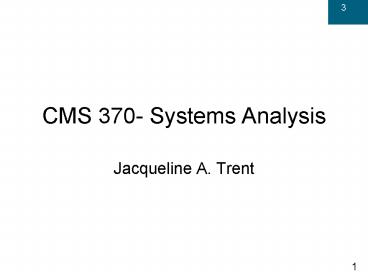CMS 370 Systems Analysis - PowerPoint PPT Presentation
1 / 37
Title:
CMS 370 Systems Analysis
Description:
Gather Information and Build Models. Figure 4-5. 8. 3. Observe and Document. Business Processes ... Figure 5-20. 24. 3. Model Things & Relationships ... – PowerPoint PPT presentation
Number of Views:33
Avg rating:3.0/5.0
Title: CMS 370 Systems Analysis
1
CMS 370- Systems Analysis
- Jacqueline A. Trent
2
Objectives
- Analysis Phase
- Identify approaches/methods for requirements
gathering - Identify and create information system models
including events tables, ER diagrams, class
diagrams
3
Class Outline
- Discussion of information gathering techniques
- Discussion and demonstration of modeling used for
requirements gathering - In-Class work on video store example
4
Review
- System Scope Document
- Captures problem description, anticipated
benefits, systems requirements to support - Context Diagram
- Graphic picture of the scope of system
identifying major players and information flow - Project Schedule
- Depicts the work - start with SDLC phases then
create tasks under each phase
5
Analysis Phase in More DetailFigure 4-1
6
Activities of the Analysis Phase and Key
QuestionsFigure 4-2
7
Gather Information and Build Models Figure 4-5
8
Observe and Document Business Processes
- Demonstrate work flows
- Create Activity Diagrams
- Functional Decomposition
9
Activity Diagram SymbolsFigure 4-11
10
Simple Activity DiagramFigure 4-12
11
Define and Document Requirements
- System requirements all capabilities and
constraints - Functional requirements
- Activities the system must perform
- Based on procedures and business functions
- Documented in analysis models
- Technical requirements
- Describes operating environment or performance
objectives - Documented in narrative descriptions of technical
requirements
12
Validating and Prioritize Requirements
- Make sure gathered information is correct
- Structured walkthrough
- Effective means of implementing quality control
early in project - Verify and validate system requirements
- Review of findings from investigation and of
models based on findings
13
Modeling Requirements
- Analyst describes system requirements using a
collection of models - Complex systems require more than one type of
model - Models represent some aspect of the system being
built - Identify the events and things from gathered
information
14
Events and System Requirements
- Events
- Occurrences at a specific time and place
- Trigger all system processing
- Requirement definition
- Determine relevant events
- External events first
- Temporal events second
- Decompose system into manageable units
15
Types of Events
- External
- Outside system
- Initiated by external agent or actor
- Temporal
- Occurs as result of reaching a point in time
- Based on system deadlines
- State
- Something inside system triggers need for
processing
16
Examples of Event Types Charge Account Processing
SystemFigure 5-6
17
Create an Event TableFigure 5-14
18
Video Store
- In-Class
- Create an Event Table based on your own
experience
19
Things and System Requirements
- What system information needs to be stored
- Outcomes
- Understanding of system
- Set of models
20
Identify THINGS from Event Table
- Step 1 Identify all nouns about the system
- Step 2 Add items or categories of information
needed - Step 3 Refine list and record assumptions or
issues to explore
21
Characteristics of Things
- Relationship
- Naturally occurring association among specific
things - Occur in two directions
- Cardinality/multiplicity
- Binary, unary, ternary, n-ary
- Attribute
- One specific piece of information about a thing
22
Relationships Naturally Occur Between
ThingsFigure 5-18
23
Attributes and Values Figure 5-20
24
Model Things Relationships
- Traditional Approach
- ER Diagrams
- Object Oriented Approach
- Class Diagrams
25
Traditional ApproachThings called Data Entities
- Things the system needs to store data about in
traditional IS approach - Modeled with entity-relationship diagram
- Generally used with relational database
development
26
Traditional Approach Simple ERD
27
Traditional Approach Cardinality Symbols of
Relationships
28
Expanded ERD with Attributes ShownFigure 5-24
29
Object-Oriented Approach Things called Objects
- Do the work in the system and store information
- Have behaviors and attributes
- Class Type of thing
- Object Specific thing
- Methods Behaviors of objects
30
Object-Oriented Approach Basic Class Diagram
- Classes objects rather than data entities
- Generalization/specialization hierarchies
- General superclasses to specialized subclasses
- Inheritance allows subclasses to share
characteristics of their superclasses - Aggregation (whole-part hierarchies)
- Relates objects and its parts
- Defines object in terms of its parts
31
Object-Oriented Approach Basic Class Symbol
32
Object-Oriented Approach Generalization/Speciali
zation
33
Object-Oriented Approach Aggregation or
Whole-Part Relationships
34
Object-Oriented Approach Bank Account System
Class Diagram
35
Video Store
- In-Class
- Identify things from Event Table based
- Create ERD or Class Diagram
36
Summary
- Analysis Phase
- Identify functional and technical requirements
- Model requirements
- Narratives, reports, lists
- Diagrams and schematics
- Event tables
- ER Diagrams
- Class Diagrams
37
Homework
- Assignment 3 Analysis your project
- Create/Obtain an activity diagram
- Create an Event table (p162)
- Create basic ER diagram(p175)
- Create a class diagram (p181)
















![[Amusing title goes here] GridPP project management PowerPoint PPT Presentation](https://s3.amazonaws.com/images.powershow.com/A1256655722dYyWr.th0.jpg?_=201507280811)














